Best Table Saw for Beginners: Problems and Guides
- January 2, 2024
- 0 comment
Embarking on the woodworking journey over the past year, I have become increasingly familiar with the table saw, a tool that has quickly established itself as an indispensable asset in my workshop. This tool offers unmatched versatility, enabling me to undertake a wide array of projects with precision and efficiency. Despite its now apparent utility, my initial experience with the table saw was marked by a sense of intimidation.
The early days of navigating the table saw’s extensive array of features and settings presented a significant challenge. With its myriad functionalities, the tool initially seemed daunting, leaving me unsure about how to fully leverage its capabilities for my woodworking endeavors.
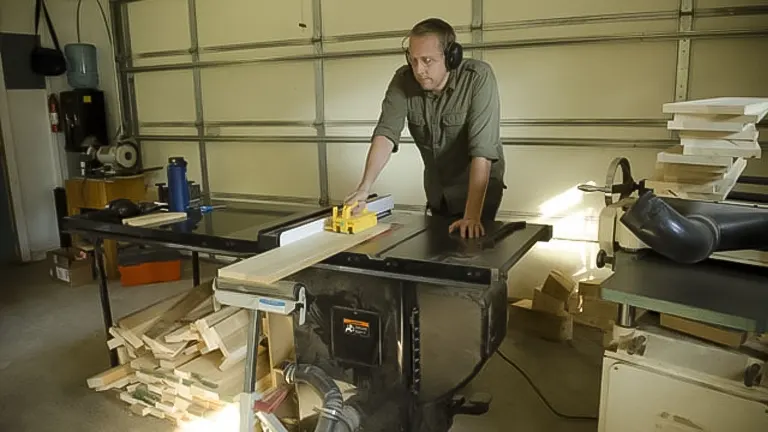
When on the lookout for table saws tailored for beginners, the foremost consideration should be safety. Opting for the cheapest model may compromise stability, making it crucial to resist the temptation of settling for a budget option. Despite being a significant investment in the workshop, the table saw warrants careful selection to ensure both quality and safety. Given the inherent risk of injury, particularly to fingers due to the exposed nature of the blade, prioritizing safety features becomes paramount.
Fortunately, manufacturers incorporate design elements that mitigate these risks. As beginners embark on their woodworking journey, it is imperative to seek a robust and well-crafted table saw, enabling precise cuts while maintaining the utmost safety. Delving into the key criteria when selecting the best table saw for beginners becomes essential, shedding light on why specific models are well-suited for those venturing into the world of table saws.
Best Table Saw for Beginners List:
- TOP PICK OVERALL: DEWALT 15 Amp Corded 10 In. Job Site Table Saw
- BEST VALUE FOR MONEY: WARRIOR 10 In. 15 Amp Table Saw
- TOP CHOICE FOR WORKSHOP USE: RIDGID 13 Amp 10 In. Professional Cast Iron Table Saw
- IDEAL FOR LIGHT-DUTY TASKS: DEWALT Table Saw for Jobsite – Compact, 8¼-Inch
- PREMIUM STATIONARY OPTION: SAWSTOP 10-Inch Professional Cabinet Saw 3-HP
- ULTIMATE PORTABILITY: Bosch 10 In. Worksite Table Saw with Gravity Rise
Factors to Deliberate on When Selecting the Optimal Table Saw for Beginners
Choosing the right table saw for beginners involves meticulous consideration of various aspects, akin to the diverse nature of power tools, with certain models better suited for specific types of cuts. The acquisition of a table saw represents a substantial investment in the realm of woodworking, demanding a thoughtful examination of project requirements and the user’s intent, whether focused on basic or advanced cuts.
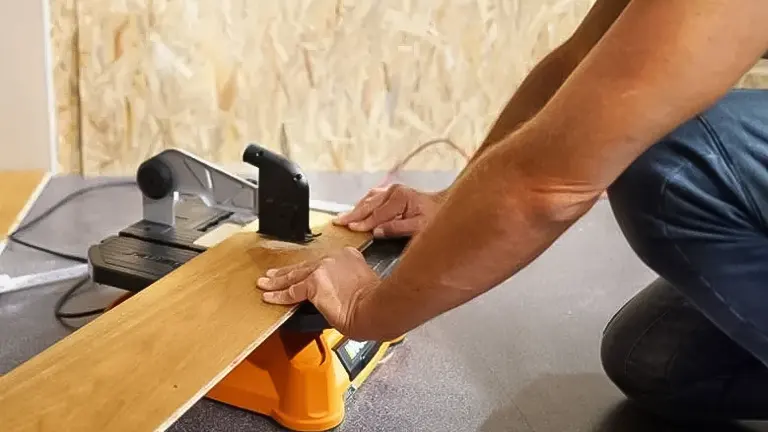
1. Type: Table saws can be broadly categorized as either “portable” or “stationary,” each containing specific subtypes.
- Job Site (Contractor): Often referred to as “contractor table saws,” these portable counterparts are robust and powerful. Mounted on collapsible stands for easy transportation, they boast full-size blades (typically 10 inches) and are designed for repetitive usage.
- Cabinet: Prominent in high school woodworking shops, cabinet table saws are notably heavy and challenging to accidentally reposition. Crafted from durable materials such as cast iron, they are built to withstand prolonged use and are favored by woodworkers with ample workshop space.
2. Size: In the context of table saws, size pertains to the diameter of the blade the tool can accommodate rather than the physical dimensions of the saw itself. The majority of table saws can accommodate 10-inch blades, while certain contractor-type models may utilize 12-inch blades, and a few opt for smaller 8¼-inch blades. Larger blades offer the capacity to cut through thicker wood, though a 10-inch blade generally suffices for most cutting applications. Careful consideration of these size variations is crucial in aligning the tool with specific woodworking needs.
In essence, the selection of the best table saw for beginners demands a nuanced understanding of the type and size that aligns with the intended projects, ensuring a seamless integration of functionality and suitability for the user’s woodworking aspirations.
Motor Power
The potency of a table saw is intricately tied to the power of its motor, making the consideration of motor types a pivotal aspect when evaluating today’s diverse range of models. Presently, table saws are equipped with two distinct motor types, each presenting a spectrum of power capabilities.
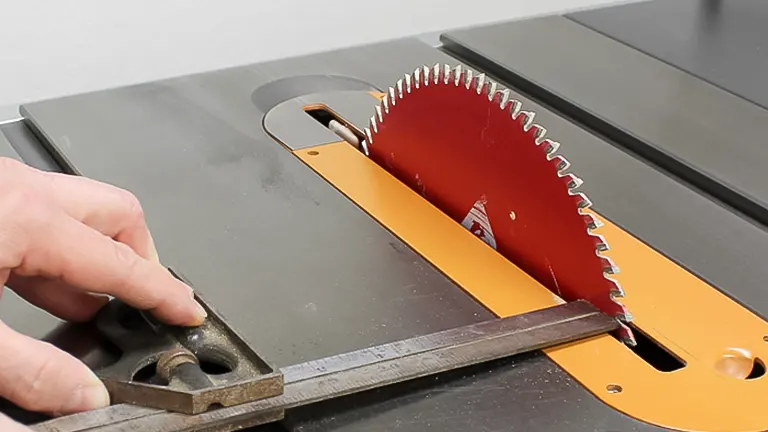
- Belt-Drive Motors: Recognized as the heavyweight contenders in the realm of table saws, belt-drive motors are predominantly found in stationary and cabinet table saws. Exhibiting robust power, these motors typically boast a horsepower (HP) range spanning from 3 to 5. However, it’s important to note that they necessitate connection to a 20-amp breaker or a 220-volt outlet to unleash their full potential.
- Direct-Drive Motors: Widely prevalent in DIY projects and the majority of contractor table saws, direct-drive motors offer a different power dynamic. With a peak performance that generally caps at 2.4 HP, these motors operate seamlessly by plugging into a standard 120-volt household outlet. While not as commanding as their belt-driven counterparts, direct-drive motors offer a practical solution for many users. However, it’s worth noting that they often emit more noise during operation.
The intricacies of motor power are pivotal in aligning the table saw with specific woodworking needs. Whether opting for the brawny belt-drive motors suitable for stationary and cabinet saws or the more accessible direct-drive motors commonly found in DIY and contractor saws, understanding these distinctions allows users to make an informed decision based on the desired power output and compatibility with workshop setups.
Table Size
The flat iron table on a table saw helps determine the maximum dimensions of the material that the saw can safely cut. A larger table means the saw can more easily and more cleanly cut large sheets of wood such as plywood.
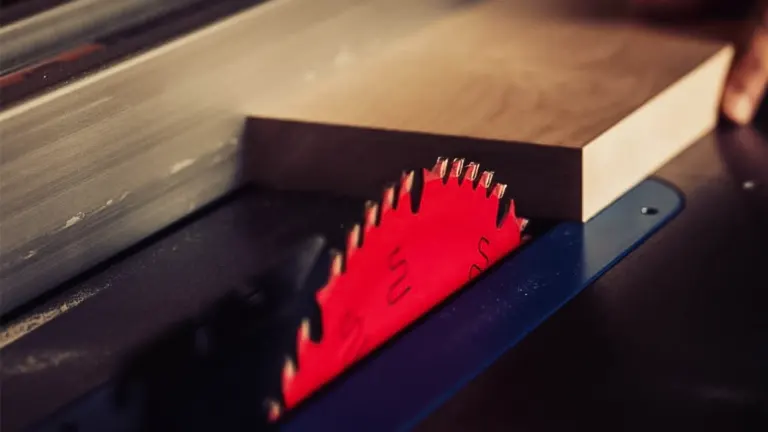
- Rip capacity: A rip cut is a cut along the length of the material, so rip capacity indicates the widest material the saw can cut. Rip capacity is determined by how far the rip fence can be moved away from the blade. Typical rip capacities include 28 inches, which is standard for compact table saws, and 30 inches, which is preferred by most contractor and prosumer DIY woodworkers. Cabinet table saws come with rip capacities of up to 50 inches, making them suitable for cutting wide sheet materials, such as full sheets of plywood.
- Crosscut capacity: A table saw’s crosscut capacity varies. It’s determined not by any measurement on the saw, but rather by how large a piece of material the user can securely hold while feeding it into the blade. It’s not uncommon to make a crosscut on a sheet of plywood wider than the table space in front of the blade.
Rip Fence
When on the quest for the best table saw for beginners, an essential factor to consider is the “rip fence,” also referred to as the “stable fence.” This adaptable bar, extending from the front to the back of the table and running parallel to the blade, plays a pivotal role in maintaining the straightness and precision of cuts.
In a physical store, it is advisable to personally test the fence’s maneuverability by adjusting it back and forth. Assessing both the ease of movement and the stability when locked in place is crucial. A flimsy fence has the potential to shift during cutting, leading to inaccuracies in the resulting cuts.
For those opting for online shopping, delving into customer reviews becomes a valuable resource. Previous buyers often share insights into the performance of the fence, shedding light on its effectiveness in maintaining stability and facilitating smooth adjustments. Taking the time to consider the rip fence’s quality ensures a more informed decision, contributing to the overall success and precision of woodworking endeavors.
Safety Considerations
Prioritizing safety is paramount when selecting a table saw, and one of the most crucial safety elements is stability. Opting for inexpensive, lightweight table saws that have the potential to tip during use poses a significant risk, especially for beginners navigating the intricacies of table saw operation. It’s imperative to recognize that such setups can swiftly turn into accidents, underscoring the importance of stability in the selection process.
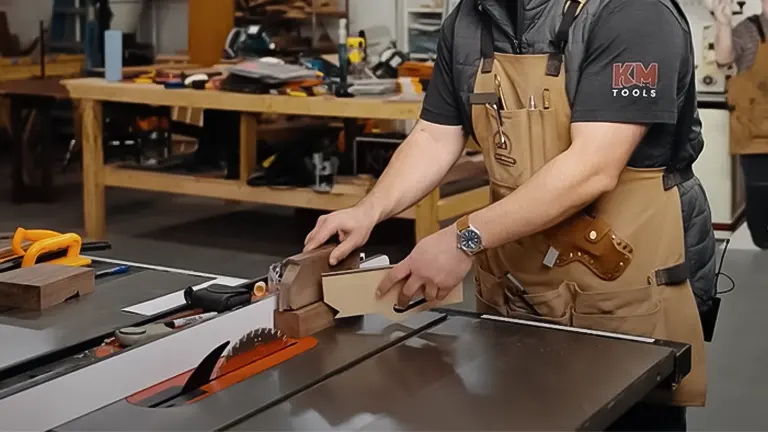
Other key safety aspects to take into account include:
- Kickback: This perilous situation arises when the spinning blade catches the material being fed into the saw, propelling it in unpredictable directions. Kickback can also pull the user’s hand toward the blade, posing a severe threat. Certain table saws are equipped with kickback claws designed to secure the material flat to the table during cutting, mitigating the risk associated with this common hazard.
- Push Blocks: Employing push blocks, or sticks, is a recommended practice to secure the material being cut and guide it through the blade without using bare hands. While some users may find these pushing accessories challenging, professionals routinely use them, recognizing their importance in preventing accidents and potential injuries, such as finger loss.
- Blade Guard: Virtually all modern table saws come equipped with blade guards designed to slide over the spinning blade. This crucial safety feature serves to reduce the risk of injuries by providing a protective barrier between the user and the blade. When exploring table saw options, ensuring the presence and effectiveness of the blade guard is essential for a safer woodworking environment.
By incorporating these safety considerations into the decision-making process, users, especially those new to table saws, can enhance their workshop safety, minimize the risk of accidents, and foster a secure environment for woodworking endeavors.
Additional Features and Accessories
While table saws may vary in power, quality, and size, they generally remain straightforward power tools. Beyond the fundamental attributes, there are several additional features and accessories worth considering.
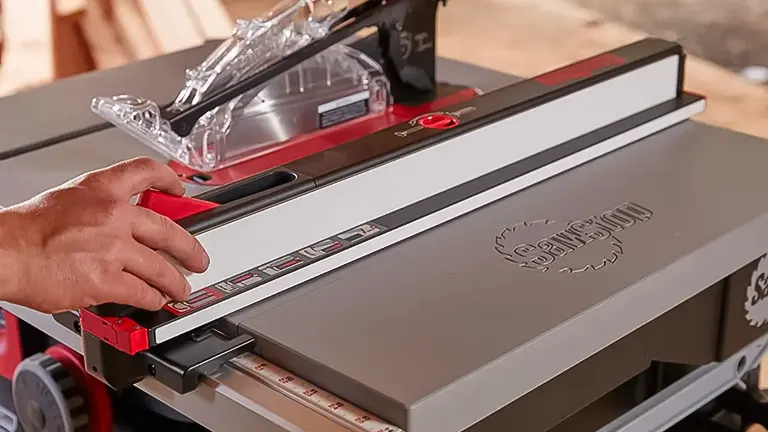
- Mitering Capability: Most table saws, including more budget-friendly models, provide the flexibility to set the blade at an angle, typically ranging from 0 to 45 degrees. This adjustment allows users to make miter (bevel) cuts, expanding the versatility of the saw for a broader range of woodworking applications.
- Magnetic Switch: While the standard on/off switch is a common feature on most table saws and is typically located on the front of the tool, some models go the extra mile with magnetic switches. These switches automatically shut off the saw in the event of motor overheating, adding an additional layer of safety and protection to the tool.
- Dust Collection: While not a universal feature, dust collection is available in some table saws and proves particularly beneficial when operating the saw in indoor settings. Many saws equipped with dust collection ports are designed to connect to standard wet/dry vacuum hoses. This feature aids in collecting the finer particles of sawdust that would otherwise disperse into the air, contributing to a cleaner and healthier working environment.
Usability Considerations for Table Saws
The ease of use of a table saw encompasses several crucial aspects that collectively contribute to the overall performance and safety of the tool. Stability stands as a foundational factor, and a larger size is often advantageous for beginners due to its inherent weight and stability, ensuring a safer and more manageable operation.
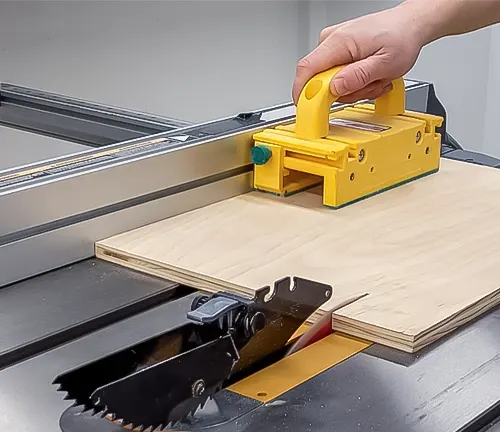
One pivotal element influencing ease of use is the locking mechanism integrated into the rip fence. A reliable locking mechanism enhances precision and stability during cutting tasks, providing a user-friendly experience. Additionally, the precision miter adjustment capability is a key determinant, as it facilitates accurate angled cuts, contributing to the tool’s overall ease of use.
Convenience features such as the placement of the power switch at the front of the machine play a significant role. This strategic positioning allows for quick and easy access, enhancing operational efficiency and user comfort. Furthermore, the size and composition of the table are crucial considerations. A spacious iron table provides a stable platform for holding materials, contributing to the overall usability of the table saw.
Brand Reputation and Warranty Considerations
When exploring the realm of table saws, it’s noteworthy that certain brands renowned for their quality often pair their products with robust warranty offerings. Notable examples include DeWalt, SKIL, and Rockwell, which typically provide customers with a 3-year limited warranty. Going above and beyond, Powermatic table saws commonly boast an extended 5-year warranty period.
However, it’s imperative for consumers to delve into the details outlined in the warranty documentation. Some nuances in coverage may exist, especially concerning repairs. Certain power tool manufacturers restrict warranty-covered repairs to those executed exclusively by their designated technicians. Consequently, if a brand-specific technician isn’t readily available in your local community, the company may impose shipping fees for repair services.
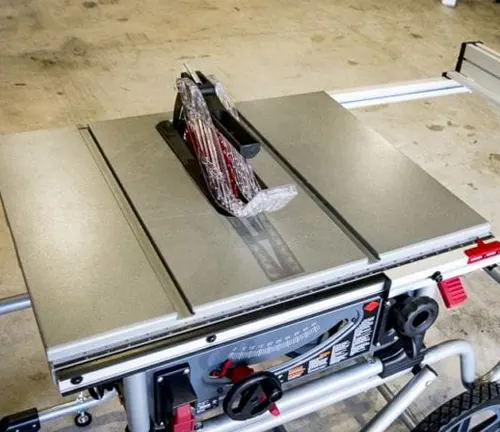
Furthermore, it’s crucial to grasp the limitations of these warranties. Most warranties are delimited to instances of damage or failure arising from factory defects. Any usage of the table saw in a manner contrary to its intended purpose, such as cutting materials like iron, typically results in the voiding of the warranty. This underscores the importance of meticulously perusing the owner’s manual before initiating tool use, serving as an additional incentive for users to acquaint themselves with the prescribed guidelines to ensure warranty validity.
Featured Selections
To earn a spot in our compilation of the finest table saws for beginners, we rigorously assessed the stability and ease of operation of the following models. Safety takes precedence when acquainting oneself with table saw usage, but the capacity to execute accurate cuts is equally paramount. Our criteria for inclusion in this selection mandated that the chosen models excel in both aspects. Despite differences in their optimal applications, each showcased table saw stands out in its respective category, collectively representing some of the premier options for woodworking enthusiasts.
1. DEWALT 15 Amp Corded 10 In. Job Site Table Saw
Advantages
- Well-suited for cutting 4×8 sheet goods
- Equipped with a safety blade guard
- Sturdy and stable construction
- Easy-to-adjust fence and miter
Drawbacks
- Wheels made of molded plastic
Brief Specifications
- Rip Capacity: 32½ inches
- Blade Diameter: 10 inches
- Amps: 15 amps
Emerging as the top choice for novice woodworkers is a table saw model crafted by one of the leading manufacturers in power tools. The DeWalt 15 Amp Corded 10 in. Job Site Table Saw stands out for its blend of power, accuracy, and safety features, catering to both beginners and experienced carpenters alike. Noteworthy attributes include an easily adjustable fence and a generous 32½-inch rip capacity, enabling users to effortlessly cut large sheet materials.

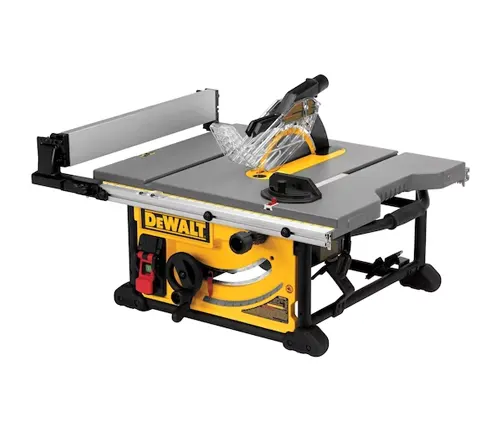
Despite its substantial weight of 110 pounds, the DeWalt table saw incorporates built-in wheels, facilitating mobility as users can tip the table on its side and roll it between work areas. The saw blade’s tilting capability up to 45 degrees allows for miter and bevel cuts, complemented by the inclusion of a blade guard and an optional dust port. Additionally, the DeWalt Table Saw boasts a practical onboard storage compartment, ideal for housing small tools such as wrenches or miter gauges. With its emphasis on safety, user-friendliness, and precise cutting, this table saw presents an exceptional combination of features for woodworkers at all skill levels.
2. WARRIOR 10 In. 15 Amp Table Saw
Advantages
- Robust 15-amp motor
- Cost-effective
- Convenient onboard storage
- Stable performance on a benchtop
Drawbacks
- Limited rip capacity of 9 inches
Brief Specifications
- Rip Capacity: 9 inches (can be set on either the right or left)
- Blade Diameter: 10 inches
- Amps: 15 amps
While the Warrior 10 In. 15 Amp Table Saw may not boast the ability to cut the largest sheet materials, it excels as a robust and precise saw that prioritizes both safety and accuracy. What sets it apart is its affordability, making it an attractive option for users seeking a powerful yet budget-friendly tool.
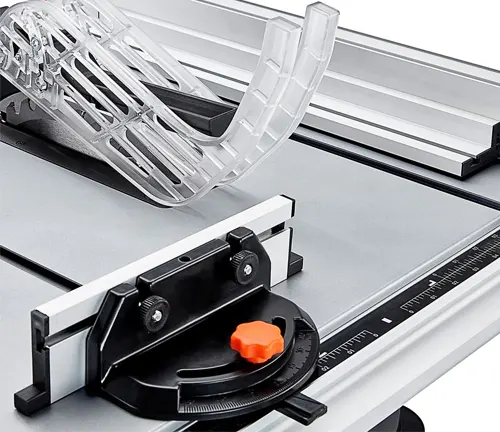
Designed as a standard benchtop table saw, the Warrior table saw has a weight of 36 pounds, providing sufficient heft to prevent unintended sliding, complemented by rubber feet for enhanced stability. Although its 9-inch rip capacity leans toward the narrower side, it proves adequate for cutting various standard woodworking boards. The fence on the Warrior operates smoothly, ensuring precise cuts, and can be securely locked into place. Notably, it offers the flexibility of attachment to either side of the table.
For added versatility, the Warrior facilitates miter cuts up to 45 degrees, catering to a range of cutting requirements. The inclusion of a dust-collection port contributes to a cleaner working environment. In summary, the Warrior 10 In. 15 Amp Table Saw presents a compelling combination of features, making it a commendable choice for users seeking a powerful, safe, and budget-conscious table saw.
3. RIDGID 13 Amp 10 In. Professional Cast Iron Table Saw
Advantages
- Exceptional stability
- Smooth operation of the rip fence
- Safety-enhancing blade guard
Drawbacks
- Equipped with a 13-amp motor
Brief Specifications
- Rip Capacity: 30 inches
- Blade Diameter: 10 inches
- Amps: 13 amps
For individuals fortunate enough to have the space for a dedicated table saw, the RIDGID 13 Amp 10 in. Professional Cast Iron Table Saw emerges as a formidable option. This robust and heavy-duty saw, weighing an impressive 267 pounds, is best suited for a fixed location. While it can serve as a primary job-site saw if anchored securely throughout a project, its substantial weight indicates a preference for a stable setup.

Powered by a 13-amp motor, the RIDGID table saw boasts a substantial 30-inch rip capacity, catering to the cutting needs of large sheet materials. Miter cuts up to 45 degrees are within its capabilities, and it includes a dust-collection port to minimize airborne dust in the workshop. The fence operates seamlessly, locking securely in place for precision cuts. Safety features include a reliable blade guard, and the metal stand with rubber feet ensures anti-slide stability.
Additional conveniences enhance its appeal, such as an onboard storage compartment for small tools and the inclusion of a push stick. In summary, the RIDGID 13 Amp 10 in. Professional Cast Iron Table Saw is a robust choice for those with the space and need for a dedicated, high-performance table saw in their workshop.
4. DEWALT Table Saw for Jobsite – Compact 8¼-Inch
Advantages
- Compact design
- Powerful performance
- High-quality construction
Drawbacks
- Relatively modest 24½-inch rip capacity
Brief Specifications
- Rip Capacity: 24½ inches
- Blade Diameter: 8¼ inches
- Amps: 15 amps
Opting for a compact table saw doesn’t necessitate compromising on power and precision. The DeWalt Table Saw, weighing in at 56 pounds, distinguishes itself as smaller than some competitors but maintains robust performance. Despite its utilization of a smaller 8¼-inch blade, it houses a formidable 15-amp motor and incorporates a modular guard system for enhanced safety. The table saw boasts a smooth-slide fence with precision locking, ensuring accurate and secure cuts.
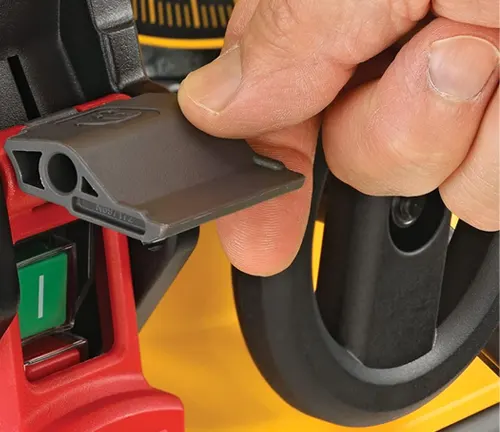

Safety features include kickback pawls designed to secure the material, reducing the risk of kickback during operation. Additionally, the saw is equipped with a push stick for safe cutting practices. With a rip capacity of 24½ inches, it proves adept at cutting moderate-size sheet materials, and its capacity for miter cuts extends up to 48 degrees.
The DeWalt table saw is designed for convenience, featuring onboard tool storage and the flexibility to function as a portable table saw or be securely mounted to a workbench for added stability. In essence, this detailed overview underscores the DeWalt Table Saw’s capacity to deliver power, precision, and safety within its compact and versatile design.
5. SAWSTOP 10-Inch Professional Cabinet Saw 3-HP

Advantages
- Exceptionally stable
- Well-suited for cutting large sheet materials
- Advanced safety system
Drawbacks
- Lack of portability
Specifications
- Rip Capacity: 36 inches
- Blade Diameter: 10 inches
- Amps: 13 amps (3 HP motor)
The SawStop 10-Inch Professional Cabinet Saw stands out with a plethora of high-end features, albeit sacrificing portability. This substantial saw, tipping the scales at 426 pounds, demands careful consideration of its permanent location within the workshop due to its lack of portability. Boasting an impressive 36-inch rip capacity, the SawStop is primed for cutting even the largest sheet materials.

Notable features include a precision-adjustable fence for accurate cuts, a dust-collection port for maintaining a clean workspace, and a blade guard for enhanced safety during cutting operations. Setting the SawStop apart from its counterparts is its exceptional power, driven by a robust 13-amp (3 HP) motor.
However, the heightened horsepower necessitates connecting the saw to either a 220-volt outlet or a 20-amp outlet. The SawStop incorporates cutting-edge safety technology that detects skin contact with the blade, promptly shutting down the motor to mitigate the risk of serious injuries. Furthermore, when the blade ceases rotation, it automatically retracts beneath the table level, preventing accidental scrapes and cuts from incidental contact. In essence, the SawStop 10-Inch Professional Cabinet Saw combines advanced features with a robust safety mechanism, making it a powerhouse for woodworking tasks within a dedicated workshop setting.
6. Bosch 10 In. Worksite Table Saw with Gravity-Rise
Advantages
- Portability
- Powerful performance
- Smart Guard System
- Extendable table for increased rip capacity
Drawbacks
- Requires use on level ground
Specifications
- Rip Capacity: 30 inches
- Blade Diameter: 10 inches
- Amps: 15 amps
Eliminating the hassle of shuttling between a stationary table saw in the garage and a DIY project in the backyard, the Bosch 10 in. Worksite Table Saw presents an optimal solution. Boasting a robust 15-amp motor, this saw delivers ample cutting power while ensuring effortless mobility. Mounted on a wheeled stand that conveniently collapses and tilts sideways, akin to a dolly, the Bosch saw becomes effortlessly transportable.
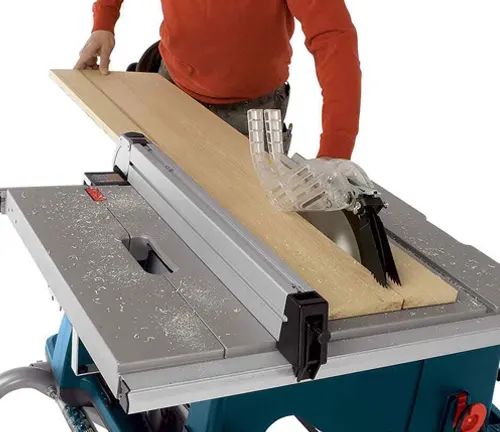
Upon reaching the designated work area, the setup process is streamlined by the gravity-rise system, facilitating the elevation of the tool to its operational height. Further enhancing its utility, the saw features a 30-inch rip capacity, a self-aligning rip fence for precision cuts, and an easily adjustable miter gauge capable of cutting up to 45 degrees.
The Smart Guard System integrated into the saw serves as a protective shield for the blade, effectively reducing kickback and enhancing overall safety during operation. In essence, the Bosch 10 in. Worksite Table Saw blends cutting-edge features with mobility, making it a practical and user-friendly choice for various woodworking applications.
How We Selected the Optimal Table Saws for Beginners
In curating the finest options for novice woodworkers in the realm of table saws, our criteria were rooted in understanding the fundamental requirements of those venturing into the use of this potent tool. Unlike beginner tools in other categories that might sacrifice power or cost, the same principle does not necessarily apply to table saws. Given the higher incidence of injuries, notably finger or hand amputations, associated with table saws compared to other power tools, prioritizing quality and safety features is paramount, making compromise in these areas untenable.
With this perspective, our selection process involved a meticulous examination of numerous contemporary table saw models. Our goal was to identify units that seamlessly amalgamate ease of use, safety, robust construction, and precision. We focused on models from reputable manufacturers with established track records for delivering quality, while remaining open to consideration of models from smaller or niche manufacturers if they demonstrated the use of quality materials and boasted a stellar reputation.
Acknowledging that table saws are substantial investments, we recognize that quality and safety are non-negotiables in this context. Despite the relatively higher cost, a good table saw should prove to be a lasting tool, ensuring years of reliable performance and providing an elevated standard of safety for the user.
Final Thoughts
Among the choices presented in this curated selection of top table saws for beginners, any option is apt for those entering the realm of table saws for the first time. However, our ultimate recommendation, the DeWalt 10-inch table saw, emerges as the standout choice, encompassing a comprehensive set of attributes. It strikes a harmonious balance between robust power, advanced safety features, and precise cutting capabilities.
Earning the title of the best overall pick, the DeWalt 10-inch table saw encapsulates the quintessential qualities desired by both novice and seasoned users. On the other end of the spectrum, the WARRIOR table saw, designated as the best budget model, doesn’t compromise on stability and incorporates features commonly found in pricier alternatives. In essence, while all options cater to beginners, the DeWalt 10-inch table saw stands out as the epitome of excellence, offering a seamless fusion of power, safety, and precision cutting for an optimal woodworking experience.
Frequently Asked Questions
Incorporating a table saw into your arsenal of power tools introduces a wide array of possibilities for woodcutting, particularly in enabling precise lengthwise cuts (rips) on materials. Individuals in search of the best saw for beginners often have specific inquiries.
- What is the horsepower of a 15-amp table saw?
Horsepower is contingent on the saw’s motor and electrical consumption. A 15-amp table saw, compatible with a standard 120-volt outlet, can generate a maximum of 2.4 HP. This calculation is based on the assumption that a 120-volt outlet produces 1,800 watts of electricity. - Can I rip a 2×4 board on a table saw?
Certainly, but it’s advisable to use a push block to guide the wood through the blade, ensuring safe handling and preventing fingers from getting too close to the blade. - What tasks should you avoid with a table saw?
Avoid attempting curved cuts as table saws are designed exclusively for straight cuts. Feeding material into the blade at an angle increases the risk of the blade catching and potentially causing projectiles. Additionally, refrain from feeding material into the saw from the back end, as this heightens the risk of kickback. Furthermore, a table saw should not be used to cut plastic, PVC, or ferrous metals, as it is not designed for such materials. - Can you cut against the grain on a table saw?
Yes, crosscuts can be made on a table saw, and for optimal results, it is recommended to use a crosscut blade. - What are five safety rules for a table saw?
Thoroughly read the operator’s manual and acquaint yourself with the saw before initiating any cuts. Wear safety glasses and hearing protection. Utilize a push block for material guidance instead of relying on your fingers. Start the blade before introducing material—never position material against a running blade. Always unplug the table saw before changing blades. - What are the paramount features on any table saw?
The critical components on a table saw include the blade, safety guard, rip fence, and miter gauge. - How should a table saw be properly used?
Always adhere to the guidelines in the operator’s manual and observe all safety precautions. Limit cutting to wood or wood-fiber products, maintain a safe working environment by excluding children, pets, and others from the immediate area, and follow sound safety practices to mitigate the risk of table saw injuries, which are prevalent among power tool mishaps.
We’re eager to learn from your experiences! Feel free to share your personal insights and thoughts on the Best Table Saw for Beginners: Problems and Guides in the comments section below. Your valuable input could be instrumental in assisting fellow users as they navigate their choices and overcome challenges!

Edward Smith
Forestry AuthorWoodworking is about more than crafting; it's a harmonious connection with nature, mastering tools, and preserving our environment. I'm here to share my knowledge and experiences with you, forging a future where we can embrace wood's beauty and utility while safeguarding our forests' health and diversity.

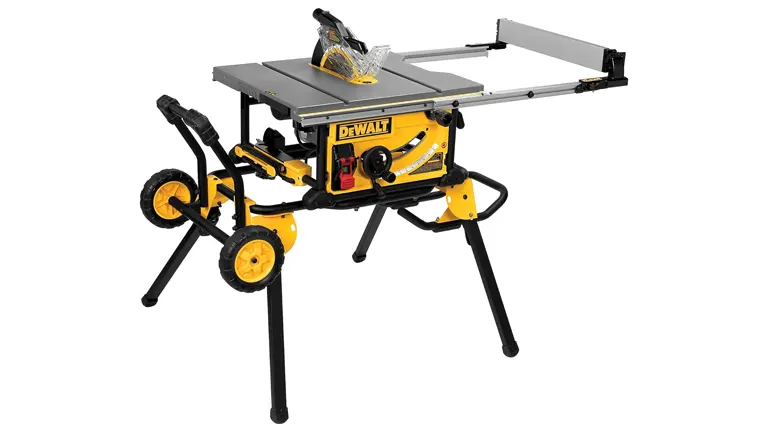
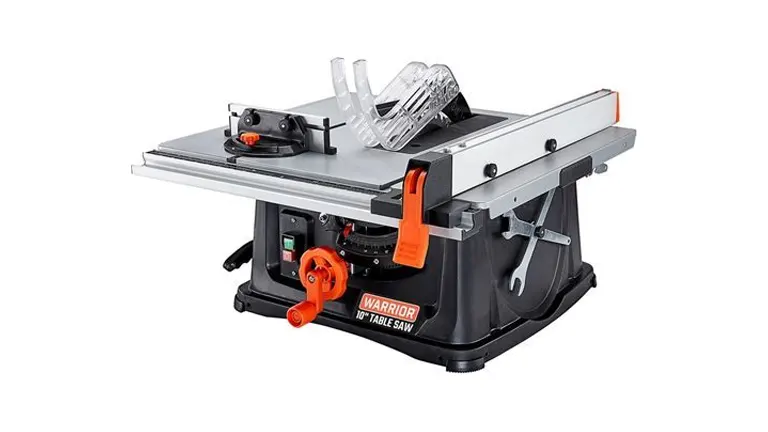

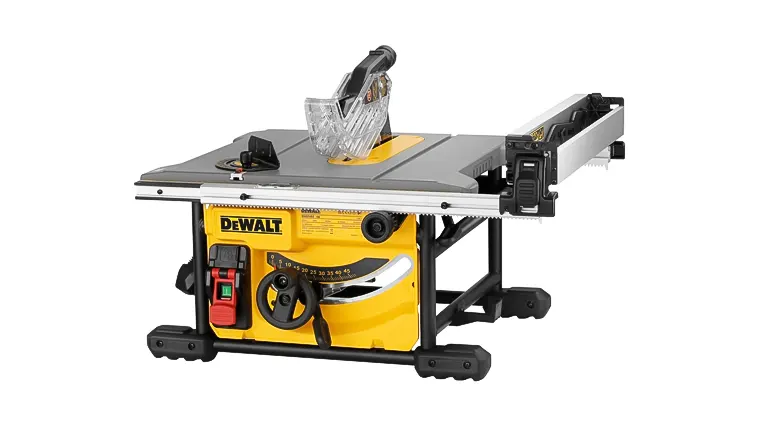












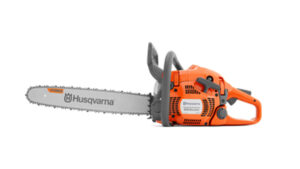
Leave your comment